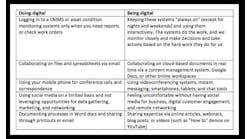Changing the approach to product development
At the Smart Industry 2018 Conference in September, Uwe Scharf presents “Accelerating Product Development In An Industry 4.0 World." Today the executive vice president of Rittal's industrial global business unit previews his presentation and shares his perspective on customer-driven innovation, mega-trends and the role of psychologists in the manufacturing space.
Take a look...
Smart Industry: Is studying customer needs the first step in innovation?Take a look…
Mr. Scharf: Yes. Before a team starts developing a new product they must find out what challenges their customers are facing and analyze these issues, which is often mixed up with asking the customers what they want. In the case of developing our VX25 large enclosure, for example, Rittal sent researchers to ten industrial companies in Germany, eight in the US and six in China—including small, medium and large companies. We spent three days at each company and documented everyday working life in writing, pictures and videos. This analysis was an eye-opener and resulted in a total of 150 specific requirements for the new enclosure. A usability study, such as the one used by Rittal, erases any doubts about the strategic direction companies should take in developing new products or services.
Smart Industry: How did you use anthropologists and psychologists in re-engineering your enclosure line?
Mr. Scharf: We chose anthropologists and psychologists who were experts in User Interface (UI) design, which is applicable not only to software but also for enclosure usage. We commissioned them for a year-long field study on three continents, going on-site to record specific data regarding users and their knowledge, preferences and motives. We also observed their tasks, the objectives of their activities, specific contextual conditions and usage scenarios.
Our usability study went much further than just user experience; it factored in tasks and context and helped us understand how people work on a scientific level. It’s this information that guides us in the right direction.
After documentation and evaluation, we shifted our focus to requirements-engineering. When we understood the requirements exactly, our research and development departments had a thorough guide for their development work.
Smart Industry: Why is studying mega-trends critical to a successful transformation?
Mr. Scharf: Before creating products with a long lifecycle you need to know what will happen during the products’ lifetime. Studying mega-trends lets us find out what is reshaping our customers’ businesses. Industry 4.0 is the fourth Industrial Revolution and has become a mega-trend of increased digitization and the interconnection of products, value chains and business models. Our studies showed us that the market needed an enclosure that immediately reduced throughput times in engineering and assembly, minimized complexity, and fits neatly into the mega-trend of digitization.
Smart Industry: How does an enterprise go about breaking habits that limit innovation?
Mr. Scharf: Breaking habits is not easy. People don’t like change.
Besides the expertise of the workforce, innovation requires a curiosity for the new, courage, determination, structure and a will to succeed. Focusing on what customers need now and in the future, along with what will make them more effective and efficient, proved to be the best way to go about becoming more innovative.
People need to be tenacious in their questioning of the status quo and accepted wisdom. They need to be able to anticipate mega-trends and incorporate them into products so that solutions are future-proofed for themselves and their customers.

